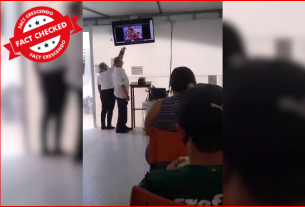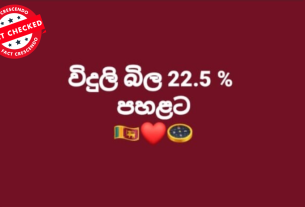Following the passing of Pope Francis on April 21, Catholics around the world, as well as the rest of the world, are eagerly waiting to see his successor.
Meanwhile, social media posts circulated indicating that the Vatican had officially released the list of 12 candidates for the papacy, which included Malcolm Cardinal Ranjith, Archbishop of Colombo. Here is an investigation we conducted to determine its accuracy.
Social Media Post :
A post was circulating on social media, including the names and the photographs of cardinals, stating, “The 12 most eminent cardinals who are qualified for the papacy”. (“පාප් පදවිය සඳහා සුදුසුකම් ඇති අති උතුම් කාදිනල්වරුන් 12 දෙනා” ) Many social media posts indicated that the Archbishop of Colombo, His Eminence Cardinal Malcolm Ranjith is also among the candidates.
Here is how these posts were circulated on Facebook.
Even new outlets indicated that Cardinal Malcolm Ranjith’s name was among those considered for successors, citing international media outlets. Newswire.

We decided to do a fact-check regarding this.
Fact Check :
The final list of cardinals eligible for the papacy has not been announced.
Although we checked to see if the Vatican had released a shortlist of 12 cardinals eligible for the papacy after Pope Francis’ passing, such a list was not found on any social media platform.
Likewise, we checked the Vatican’s official website, and they have not issued any statement regarding the papacy candidates.
Speculations made by International media reports
International media reports have named several cardinals who are considered the most suitable candidates for the next Roman Catholic Pope.
The Forbes website states them as Hean-Marc Aveline (France), Peter Erdo (Hungary), Pietro Parolin (Italy), Marc Ouellet (Canada), Luis Tagle (Philippines), Matteo Zuppi (Italy), Fridolin Ambongo (Congo), Robert Sarah (Guinea), Mario Greech (Malta).
The New York Times Website had stated that one of the cardinals was most likely to be elected from Pierbattista Pizzaballa, Pietro Parolin, Fridolin Ambongo, Luis Antonio Tagle, Matteo Zuppi, Peter Erdo, and Anders Arborelius.
The Guardian website states that the Pope would be chosen from Pietro Parolin, Luis Antonio Tagle, Peter Turkson, Peter Erdo, Matteo Zuppi, Jose Tokentino Calaca Mendonca, Mario Grech, Pierbattista Pizzaballa, and Robert Sarah.
More international media reports, including the names of cardinals speculated to be elected as the new pope, are available here, here, and here.
However, it is almost impossible to predict the outcome of the conclave to elect a pope, which is held in great secrecy, as the cardinals’ positions can change from one vote to the next. At the last conclave in 2013, Cardinal Angelo Scola of Milan was predicted to be elected pope, but Cardinal Jorge Mario Bergoglio was elected, who is now the deceased Pope Francis.
Although the name of the Archbishop of Sri Lanka, Cardinal Malcolm Ranjith, is also included in some of the international media reports that are making speculations.
ABC News points out that, according to Dr. Collins, who served as a priest for 33 years until resigning in 2001 due to a doctrinal dispute, in addition to the four cardinals appointed as main candidates, the Archbishop of Colombo, Cardinal Malcolm Ranjith, is also included in subsequent list of 18 possible candidates. You can view that article here. Archived Link
USA Today also mentioned that after some of the prominent Cardinals in line to be the new Pope, Cardinal Malcolm Ranjith could also be a possible consideration, as seen here.
However, it is essential to note that all this is speculative, as the Vatican has not issued any list of possible candidates in this regard.
Father Cyril Gamini Fernando, Media Spokesperson of the Archdiocese of Colombo
We inquired about this with the Media Spokesperson of the Archdiocese of Colombo, Father Cyril Gamini Fernando, and the Father explained that all eligible cardinals under the age of 80 can participate in this conference.
The Father also noted that there are currently 252 cardinals worldwide, of whom 135 are eligible to participate in voting.
The remaining cardinals over the age of 80 cannot vote but can participate in discussion. He stated that any of the 252 cardinals, including 77-year-old Cardinal Malcolm Ranjith, can be elected as the Pope, but explained that the Vatican has not released any candidate list.
The official procedure for electing a new pope
The election of a new pope is governed by the Apostolic Constitution Universi Dominici Gregis, promulgated by Pope John Paul II in 1996 and later revised by Pope Benedict XVI.
The main steps of this are,
Vacant Seat (Sede Vacante): The Holy See becomes vacant after the death or the resignation of a Pope
General Congregations: All cardinals, including those over the age of 80, meet in Rome to discuss the needs of the Church and prepare for the synod.
Conclave: Only cardinals of the second highest ranking of the church under the Pope vote in the election (apart from those under the age of 80) and enter the Sistine Chapel in Vatican City.
They are isolated from contact with the outside world until a new pope is elected, keeping the entire process highly secret.
According to the Vatican Press Office’s Cardinal Dashboard, there are currently 135 cardinals in the eligible category.
Voting Process:
This vote is held in a secret meeting called a conclave, which can last for days, weeks, or months, with four votes per day, until a new pope is chosen.
They vote in the Sistine Chapel and live in a dormitory at Casa Santa Marta.
The conference begins with a Divine Liturgy, after which discussion and voting begin. Voting takes place every morning and afternoon until a candidate wins a two-thirds majority. There is a daily break for prayer after every seven ballots.
The longest papal conclave in recent history was the 1922 papal election, where cardinals spent five days choosing their new leader.
Any baptized male can be elected as the Pope, but in recent history, a cardinal serving the Christianity has been chosen for this purpose. Each voter is given a ballot paper with the words “I choose to be the Supereme Pope” (eligo in summum pontificem) printed at the top. They enter the name of their choice, fold the card and place it in a cup.
Some international media reports indicate that the ballot is secret, but that does not mean the process is free from grouping, conspiracies, and influence.
After each round of voting, the ballots are burned, and the colour of the smoke is used to tell the world whether a new pope has been elected or not. Chemicals are added to make this smoke black or white. The black smoke coming out of the 60-foot chimney indicates an inconclusive vote, meaning that no pope has yet been chosen. If white smoke rises, it announces to the world that a new pope has been elected.
If the elected candidate were to assume the papacy, that is, accept the election, he would be asked what name he would choose as the pope. The cardinals pledge their obedience to the new pope and are led to the adjacent Room of Tears to be dressed in a white cassock, skullcap, and red sandals. Three suits of different sizes have been made in advance by Vatican tailors.
The Head of Cardinals will step onto the main balcony of St. Peter’s Basilica, in front of which thousands of Catholic Devotees and tourists have gathered, and he will announce, “Annuntio vobis gaudium magnum: Habemus papam”, meaning “I announce to you with great joy: we have a pope”.
These procedures are detailed in the official document, Universi Dominici Gregis, available on the Vatican website:
Acting head of the Vatican until a new pope is elected
After the death of Pope Francis, a cardinal from the United States will serve as the acting head of the Catholic Church, also known as the Vatican, until a new pope is elected.
He is Cardinal Kevin Farrell, a Dublin-born priest who became a naturalised American citizen after serving in the United States for many years. Farrell, a former bishop of Dallas, holds the position of “camerlengo,” which tasks him with overseeing and administering the temporal goods and rights of the Apostolic See after the death or resignation of a pope.
It is the camerlengo’s job to officially confirm the death of the Pope, seal and study the papal bedchamber, and prepare for the funeral. The camerlengo is also tasked with making practical arrangements for the conference, ensuring the confidentiality of proceedings and the orderly voting. More information on this can be found here.
The election of a new pope after the death of Pope Francis is scheduled to begin between 15 and 20 days after his death, and the conclave is likely to begin around May 6, 2025, according to Reuters. Depending on the results of the vote, the duration of the congress may last for several days.
Join us to learn more about our investigative fact findings.
Facebook | Twitter | Instagram | Google News | TikTok
Conclusion :
The process of electing a new pope is carried out through a voting system, and this is done by all 135 cardinal electors under the age of 80 who are eligible to vote in that process. This system follows a centuries-old tradition designed to ensure a fair and spiritual selection of the new pope and will take place between 15-20 days after the death of the pope, in early May.
Apart from this process, only speculations are currently being reported on social media locally and internationally. Vatican has not officially released the list of candidates. Therefore, the claim that Cardinal Malcolm Ranjith is listed as a possible candidate is misleading.

Title:Are only 12 cardinals qualified to be the Pope?
Written By: Fact Crescendo TeamResult: Misleading






